Contents
[1. introduction] [2. The Croagnes section]
[3. Micropaleontology] [4. Carbon isotope stratigraphy]
[5. Conclusion] [Bibliographic references]
Centre de Recherches Micropaléontologiques, Muséum d'Histoire naturelle, 60 Bd Risso, 06000 Nice (France);
Laboratoire de Géologie des Systèmes et des Réservoirs Carbonatés, Aix-Marseille Université, Campus St-Charles, Case 67, 3 Pl. Victor Hugo, 13331 Marseille Cedex 03 (France)
Laboratoire de Géologie des Systèmes et des Réservoirs Carbonatés, Aix-Marseille Université, Campus St-Charles, Case 67, 3 Pl. Victor Hugo, 13331 Marseille Cedex 03 (France)
Parc naturel régional du Luberon, 60 place Jean Jaurès, 84400 Apt (France)
Mairie de Saint-Saturnin-lès-Apt, BP 37, 84490 Saint-Saturnin-lès-Apt (France)
Manuscript online since October 2, 2012
[Editor: Bruno ; copy editor: Christian C. ;
language editor: Donald E. ]
The discovery and exploitation of a new outcrop of the "A1 Unit of yellow marls and marly limestones" of (1883), comprised between the Urgonian limestones and the "Aptian marls" of the authors, leads to question the generalized attribution of this formation to the Deshayesites grandis ammonite Subzone. Data from this section at Croagnes rather lead to place A1, at least locally in the stratotypic area of the surroundings of Apt, at the level of the onset of the anoxic event OAE1a, just below the Roloboceras hambrovi Subzone. The assumed isochroneity of this Unit is also questioned.
Aptian; Bedoulian; stratotype; microbiostratigraphy; carbon isotope stratigraphy; OAE1a.
M., G., C. & P. (2012).- A new upper Bedoulian section in the Aptian stratotypic area: Croagnes (5 km NW of Gargas, Vaucluse, SE France).- Carnets de Géologie [Notebooks on Geology], Brest, Letter 2012/03 (CG2012_L03), p. 193-199.
Une coupe inédite du Bédoulien supérieur dans l'aire stratotypique aptienne : Croagnes (5 km au NW de Gargas, Vaucluse, SE de la France).- La découverte et l'exploitation d'un nouvel affleurement de l' "Unité A1 des marnes et calcaires marneux jaunes" de (1883), comprise entre l'Urgonien et les "marnes aptiennes" des auteurs, conduit à mettre en question l'attribution généralisée de cette formation à la Sous-Zone d'ammonites à Deshayesites grandis. Les données obtenues à Croagnes permettent plutôt de la situer, au moins localement dans le secteur stratotypique des environs d'Apt, au niveau du début de l'événement anoxique OAE1a, juste avant la Sous-Zone à Roloboceras hambrovi, et remettent en question le postulat de son isochronie.
Aptien ; Bédoulien ; stratotype ; microbiostratigraphie ; stratigraphie isotopique du carbone ; OAE1a.
(1883) was the first to describe in the vicinity of Apt a thin decametric Unit of yellowish marlstones overlying the Urgonian limestones and underlying the grey-blue Aptian marls. This Unit was named "A1" and, on the basis of few ammonites, given an Early Aptian age by the author.
Subsequent
studies (, 1933; ,
1963; , 1971; ,
1976) of these beds from several
outcrops close to localities surrounding the Apt area (Gordes, Murs, Villes, Le
Chêne, Joucas) (Fig. 1 ![]() ) confirmed their Bedoulian and even more precisely late
Bedoulian age. This age assignment was particularly based on the occurrence of
the species Deshayesites deshayesi among the ammonites collected in A1.
) confirmed their Bedoulian and even more precisely late
Bedoulian age. This age assignment was particularly based on the occurrence of
the species Deshayesites deshayesi among the ammonites collected in A1.
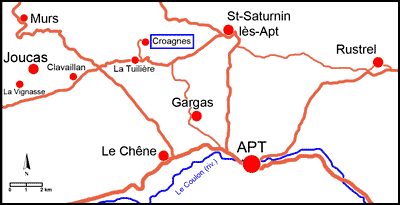
Click on thumbnail to enlarge the image.
Figure 1: Geographic location of the area of study. Croagnes is located at 43° 93' N, 5° 33' E.
This Unit A1 has recently been briefly mentioned by &
(2011) in a paper more extensively
devoted to stratigraphic correlations in the upper Barremian-lower Aptian
platform carbonates of southeast France. In this work these supra-Urgonian beds
are given a still more precise latest Bedoulian age, since they are assigned to
the Deshayesites grandis ammonite
Subzone (Fig. 2 ![]() ).
).
Micropaleontological and geochemical results that we have obtained by studying a deeply hidden outcrop discovered by one of us (P.M.) close to Croagnes shed a new light on this Unit and in particular led us to question its recent assignment to the D. grandis Subzone. The purpose of this paper is thus to provide a short description of this new outcrop and to present an overview of the first results from its study.
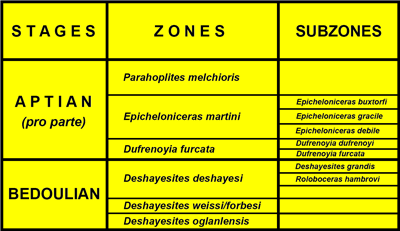
Click on thumbnail to enlarge the image.
Figure 2: Ammonite zonation of the Bedoulian and Aptian (lower part) stages (modified from , 2005; et al., 2006, 2008; et al., 2011; et al., 2011).
The studied
section (Fig. 3 ![]() ) is located within the forest of Coste Granière, 500 m NE of
the small village of Croagnes (Fig. 1
) is located within the forest of Coste Granière, 500 m NE of
the small village of Croagnes (Fig. 1 ![]() ). A 13 m thick sequence of marls,
superficially yellowish/brownish or, locally, bluish (Fig. 4
). A 13 m thick sequence of marls,
superficially yellowish/brownish or, locally, bluish (Fig. 4 ![]() ) is exposed there,
in a kind of sloped clearing. In depth marls of the first part of the section
consist of dark grey, moderately indurated, thin platelets, which become progressively
softer and darker up in the series, where they include plant debris. Echinids (Miotoxaster collegnoi) also occur,
mostly from the middle part of the section.
) is exposed there,
in a kind of sloped clearing. In depth marls of the first part of the section
consist of dark grey, moderately indurated, thin platelets, which become progressively
softer and darker up in the series, where they include plant debris. Echinids (Miotoxaster collegnoi) also occur,
mostly from the middle part of the section.
This facies and its fossil content are consistent with what is usually described as and ascribed to the A1 Unit. However, direct contacts with the supposedly enclosing beds, respectively the Urgonian limestones, which locally crop out nearby, and the Aptian marls, seen W of Croagnes, cannot be found there. Thus we analyzed samples from this series for micropaleontology and geochemistry, in order to clarify its stratigraphic status.
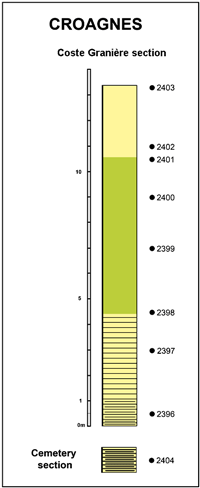
Click on thumbnail to enlarge the image.
Figure 3: Schematic log of the Croagnes sections.
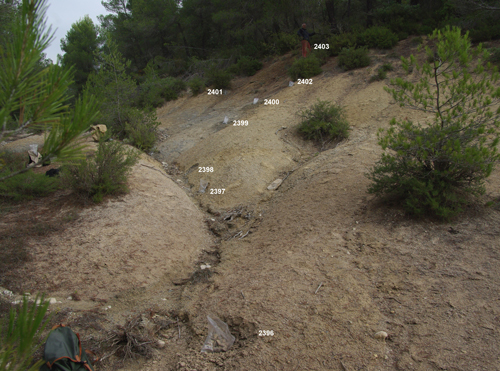
Click on thumbnail to enlarge the image.
Figure 4: Outcrop of the Croagnes (Coste Granière) section.
The foraminiferal content of the samples taken from the Croagnes section differs significantly from that ( et al., 2008) of the typical Aptian marls from the same area. Planktonic forms are very rare and low diversified, benthic foraminifers and ostracods are much more predominant. Fragments of echinids, bivalves and other invertebrates are abundant among the >250 µm washed residues. On the other hand, benthic foraminifers include there a significant proportion of very shallow water forms, such as small orbitolinids, miliolids, Arenobulimina, Nezzazzata, Trocholina, Conorboides, Patellina. These taxa are most often absent or, for some of them (Patellina), extremely rare in the typical Aptian marls. Such assemblages lead us to suggest that the deposition of the marls of Croagnes either occurred soon after the demise of the Urgonian platform or, preferably, as indicated by obvious signs of transportation, that these shallow-dwellers came from the close Urgonian platform and were redeposited in slightly deeper periplatform environments.
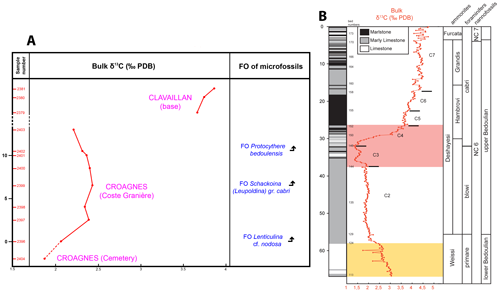
Click on thumbnail to enlarge the image.
Figure 5: A.- δ13C measurements and first occurrences of microfossil markers in the Croagnes and Clavaillan (base) sections. B.- Isotopic (δ13C) and biostratigraphic records at La Bédoule (LB1 borehole) (modified from et al., 2012).
Among the
remaining part of the microfauna from Croagnes, it is of interest to note that
three species (Fig. 5 ![]() ), which are known as well-calibrated biostratigraphic
markers in the stratotypic area of Cassis-La Bédoule ( et al.,
1998, 2005), follow a
similar global pattern of near simultaneous first appearances in both
localities:
), which are known as well-calibrated biostratigraphic
markers in the stratotypic area of Cassis-La Bédoule ( et al.,
1998, 2005), follow a
similar global pattern of near simultaneous first appearances in both
localities:
In Cassis-La Bédoule the sequence
from bed 137 to bed 147 is located just below the lower boundary (bed 148) of
the ammonite Roloboceras hambrovi Subzone (Figs. 2 ![]() & 5
& 5 ![]() ) of the D. deshayesi Zone ( et al.,
2006). On the
other hand, in a well at La Bédoule ( et al., 2012) bed 146 has been
correlated with the C3/C4 et al. (1998) isotopic stages boundary (Fig. 5
) of the D. deshayesi Zone ( et al.,
2006). On the
other hand, in a well at La Bédoule ( et al., 2012) bed 146 has been
correlated with the C3/C4 et al. (1998) isotopic stages boundary (Fig. 5 ![]() ). Thus, on the basis of
these three microfaunal markers, the Croagnes section appears to straddle both
the lower boundary of the Roloboceras
hambrovi ammonite Subzone and that of the Schackoina (Leupoldina) cabri foraminiferal Zone, as well as the
C3/C4 transition.
). Thus, on the basis of
these three microfaunal markers, the Croagnes section appears to straddle both
the lower boundary of the Roloboceras
hambrovi ammonite Subzone and that of the Schackoina (Leupoldina) cabri foraminiferal Zone, as well as the
C3/C4 transition.
In view to better constrain these stratigraphic hypotheses based on correlations with the stratotypic area of Cassis-La Bédoule, isotopic measurements for δ13C were performed on 9 samples from Croagnes at the Leibniz-Laboratory for radiometric Dating and Isotope Research in Kiel (Germany). This set of samples included 8 samples from the Coste Granière section, and one taken from a small isolated outcrop located across the Cemetery of Croagnes; the geometric position, the facies (grey-blue yellowish platy marly limestone) and the composition of the microfaunal content of this outcrop led us to place it slightly below the base of the Coste Granière section, i.e., still closer to the top of the Urgonian.
The
measured values and the signature of the plotted curve at Croagnes (Fig. 5 ![]() )
appear to be consistent with the middle/upper part of the C3 isotopic stage and
its transition towards C4.
)
appear to be consistent with the middle/upper part of the C3 isotopic stage and
its transition towards C4.
As a kind
of counterproof, δ13C measurements were also performed on three samples of upper Bedoulian
marlstones from the base of the section of Clavaillan (Figs. 1 ![]() & 6
& 6 ![]() ), 2 km WSW of
Croagnes, where numerous ammonites of the Deshayesites
grandis Subzone have been found (, 2005; plus our own record). The δ13C values obtained there (Fig. 5
), 2 km WSW of
Croagnes, where numerous ammonites of the Deshayesites
grandis Subzone have been found (, 2005; plus our own record). The δ13C values obtained there (Fig. 5 ![]() ) are significantly
higher than those from Croagnes and very close to those of the C6/C7 transition
measured in Cassis ( et al., 1998) and La
Bédoule ( et al., 2011; et al.,
2012) at the level of the
base of the Deshayesites grandis Subzone.
) are significantly
higher than those from Croagnes and very close to those of the C6/C7 transition
measured in Cassis ( et al., 1998) and La
Bédoule ( et al., 2011; et al.,
2012) at the level of the
base of the Deshayesites grandis Subzone.
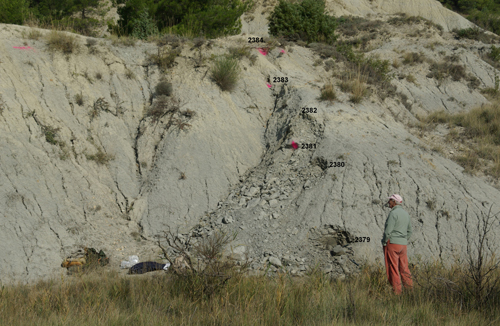
Click on thumbnail to enlarge the image.
Figure 6: Outcrop of the base of the Clavaillan section, where ammonites of the D. grandis Subzone have been found.
Preliminary micropaleontological and isotopic data obtained from a newly discovered "A1 like" section at Croagnes point to ascribe this outcrop to the middle part of the late Bedoulian, around the onset of the OAE1a event. These beds cannot be attributed there to the Deshayesites grandis Subzone, an age recently assigned by & (2011) to all the other known outcrops of the A1 Unit. Our results led also to assume that in the area of Croagnes there is a gap of observation between A1 and younger beds indisputably dated of the D. grandis Subzone, which show the lithological facies and microfaunal content of the typical "Aptian marls". This gap must cover at least the most part of the isotopic stage C4, the entire C5 and most of C6.
However, before reconsidering the global age assignment of & (2011) quoted above, further micropaleontological and isotopic researches ought to be carried out on all the other known outcrops of this Unit, the isochroneity of which is not fully demonstrated yet.
We thank Wolfgang and Janne (University of Kiel, Germany) for having taken care of the isotopic measurements proceeded at the Leibniz-Laboratory for radiometric Dating and Isotope Research, and Pierre (Marseille) for the determination of the ammonites collected in the Clavaillan section. We also thank Bernard (Messery), Yves (Museum of Aix en Provence) and Zdeněk (VSB-Technical University Ostrava, Czech Republic) for their constructive reviews of a first version of the manuscript, as well as Donald E. (Lamar University, USA), for his assistance in revising the English text.
M.T. (1963).- Contribution à l'étude sédimentologique et paléocéanographique des terrains aptiens et albiens de la Provence aux Baronnies.- Recueil des Travaux de la Station marine d'Endoume, Marseille, vol. 30, n° 45, p. 95-164.
Y. (2005).- Biostratigraphie, évolution et renouvellements des ammonites de l'Aptien supérieur (Gargasien) du bassin vocontien (Sud-Est de la France).- Thèse Université Claude Bernard, Lyon 1, 302 p. (31 pls.).
J. (1933).- Sur l'extension des faciés urgoniens dans les monts de Vaucluse.- Bulletin de la Société géologique de France, Paris, (série 5), vol. 2, p. 445-464.
W., M., J.-P&H. (1998).- Carbon isotope stratigraphy of the lower Aptian historical stratotype at Cassis-La Bédoule (S.E. France).- Géologie méditerranéenne, Marseille, vol. 25, n° 3-4, p. 63-79.
W., A. & M. (2011).- Transient global cooling at onset of early Aptian Anoxic Event (OAE 1a).- Geology, Boulder, vol. 39, n° 4, p. 323-326.
F.(1883).- Étude géologique de la région du Mont-Ventoux.- Thèse Doctorat ès Sciences, Universités de Montpellier et de Paris, 273 p.
J., W., A., S., M. & G. (2012, in press).- A new sediment core from the Bedoulian (Lower Aptian) stratotype at Roquefort-La Bédoule, SE France.- Cretaceous Research, London, 11 p. doi:10.1016/j.cretres.2012.03.019
J.-P. (1976).- Les calcaires urgoniens de Provence (Valanginien-Aptien inférieur). Stratigraphie, paléontologie, les paléoenvironnements et leur évolution.- Thèse Doctorat ès Sciences, Université d'Aix-Marseille II, 445 p.
J.-P. & M. (2011).- Drowning discontinuities and stratigraphic correlation in platform carbonates. The late Barremian-Early Aptian record of southeast France.- Cretaceous Research, London, vol. 32, n° 6, p. 659-684.
A.P., H., R., R.V., P., A. & M. (1998).- High-resolution δ13C stratigraphy through the early Aptian "Livello Selli" of the Alpine Tethys.- Paleoceanography, Washington D.C., vol. 13, n° 5, p. 530-545.
M.,G.,W.& J.-P. (1998).- Les Foraminifères benthiques et planctoniques de la série du stratotype historique de l'Aptien inférieur dans la région de Cassis-La Bédoule (SE France).- Géologie Méditerranéenne, Marseille, vol. 25, n° 3-4, p. 187-225.
M.,J.-P&G. (2005).- Le Gargasien (Aptien moyen) de Cassis-La Bédoule (stratotype historique de l'Aptien inférieur, SE France) : associations et biostratigraphie des Foraminifères benthiques et planctoniques.- Carnets de Géologie - Notebooks on Geology, Brest, Article 2005/02 (CG2005_A02), 20 p. (5 Pls.).
M G. &J.-P. (2008).- Associations et biostratigraphie des Foraminifères benthiques et planctoniques du Bédoulien sommital et du Gargasien inférieur de La Tuilière - St-Saturnin-lès-Apt (aire stratotypique de l'Aptien, Vaucluse, SE France).- Carnets de Géologie - Notebooks on Geology, Brest, Article 2008/01 (CG2008_A01), 50 p. (10 Pls.).
M., B. & G. (2011).- The Aptian stage: back to fundamentals.- Episodes, Bangalore, vol. 34, n° 3, p. 148-156.
S., P.F., J. A., M.B., R., Y., M., C., V.I., A., B., V., H., Z., E.J., D., S., T.N., L.G., J.L., I.A., P. & O. (2011).- Report on the 4th International Meeting of the IUGS Lower Cretaceous Ammonite Working Group, the " Group" (Dijon, France, 2010).- Cretaceous Research, London, vol. 32, n° 6, p. 786-793.
E. (1971).- Géologie du pays d'Apt (première partie).- Bulletin du Bureau de Recherches géologiques et minières, Orléans, sect. 4, n° 3, p. 29-57.
P., M., R., G. & G. (2006).– The Deshayesitidae , 1949 (Ammonoidea) of the Aptian stratotype region at Cassis-la Bédoule (SE France).- Carnets de Géologie - Notebooks on Geology, Brest, Memoir 2006/01 (CG2006_M01), 46 p. (14 Pls.).
P., G., M., G. & R. (2008).- The Douvilleiceratidae (Ammonoidea) of the Lower Aptian historical stratotype area at Cassis-La Bédoule (SE France).- Carnets de Géologie - Notebooks on Geology, Brest, Memoir 2008/03 (CG2008_M03), 60 p. (24 Pls.).